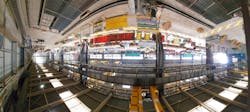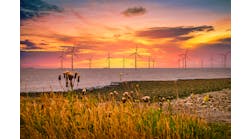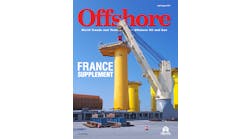Demand for new sources of renewable energy continue to surge across Europe, with France emerging as a test bed for floating offshore wind.
Eiffage Métal, one of Europe’s major players in mass production of jackets and foundation structures for fixed offshore wind turbines, has more recently secured work for two transformer substations in Dutch waters and for two pilot floater projects in deeper waters in the Mediterranean Sea off southern France. The company is now looking to increase its manufacturing capacity to manage its growing workload.
Last year, the company’s Belgian subsidiary Smulders completed delivery of 55 jackets for EDPR/ENGIE’s Moray East wind farm in the North Sea off northeast Scotland. Each of the three-legged, 85-m (279-ft) tall, weighed 1,000 metric tons (1,102 tons). Eiffage Métal yards and workshops in Belgium, France, and Poland were involved in the fabrication, with final assembly performed at the company’s Wallsend site on the River Tyne in northeast England. Smulders’ consortium partner DEME was recently completing the offshore installations.
The same companies are collaborating on France’s first offshore wind farm, 12-20 km (7.5-12 mi) offshore Saint-Nazaire on the west coast, develop by EDF Renewables. Smulders in Antwerp is constructing the transition piece foundations for the 80 wind turbines, while Sif in Roermond, the Netherlands is handling the monopiles. DEME’s Innovation vessel started the offshore installation campaign this spring, using a specially-developed subsea waves protection device. This allows the monopiles and foundations to be either driven, drilled, or drilled and driven, as required by the variable seabed, occasionally rocky soil conditions across the site. The technique has worked successfully so far, said Arnaud de Villepin, Industrial Division Director at Eiffage Métal, pointing out that the 7.5-m (24.6-ft) diameter holes drilled by the machine are comparable with those drilled during construction of the road or rails onshore. Fabrication should finish by the end of August, with all the completed 80 turbine structures due to be installed by summer 2022.
Smulders and Sif are also in a consortium working on phases A and B of the 3-GW Dogger Bank wind farm, the largest in the world to date, located over 130 km (81 mi) from the Yorkshire coast off northeast England. It will also be the UK’s first offshore wind farm to employ an HVDC transmission system. Phases A and B will require a total of 190 foundations for installation in water depths from 18-63 m (59-207 ft). In May, Smulders’ sites in Belgium and Poland started fabrication of the secondary steel for the transition pieces: Sif is manufacturing the monopiles and the primary steel for the transition pieces, which Smulders will subsequently assemble, coat, and test at its facility in Hoboken.
In June, first steel pieces (nodes and plate girders) were cut for the topsides of the offshore transformer substation for Hollandse Kust (west Alpha), one of three 700-MW platforms under construction for wind farms along the Dutch North Sea coast. A joint venture between ENGIE Solutions and lemants (a subsidiary of Smulders) is responsible for delivery of west Alpha and the Hollandske Kust (noord) substations to TenneT. Smulders’ facilities in Arendonk, Balen central Belgium and Hoboken, near Antwerp, started fabricating steel structures for west Alpha in July; this was followed by the start of the jacket fabrication done in Belgium.
The completed topsides deck sections will be transferred to ENGIE Solutions’ yard in Hoboken for installation of all auxiliary equipment and integration of free-issued MV/LV equipment from 4Q onwards. Offshore installation of the completed jacket and topsides is scheduled respectively for summer 2022 and summer 2023. According to de Villepin, offshore substations, driven by Siemens in particular, have evolved away from the earlier, more complex designs to more modular structures that are simpler, and therefore less costly, to construct.
In the Mediterranean, Eiffage Métal’s yard in Fos-sur-Mer has work for two offshore floating wind developments. One is EDF Renewables’ Provence Grand Large, based on a proprietary floating structure concept developed by SBM Offshore and IFP Energies Nouvelles to address the constraints and requirements of offshore wind turbines. This is said to be lightweight and modular, with low motions and accelerations at nacelle level. The pilot (Provence Grand Large) will support three Siemens 8-MW wind turbines and will be located in 70 m (230 ft) of water, 17 km (10.6 mi) offshore Port Saint Louis du Rhône. Engineering and fabrication of the three floaters started at Fos in February.
The second project, again a demonstrator, is the Leucate floating offshore wind farm developed by a consortium of Ocean Winds and Caisse de Depots (Les Eoliennes Flotantes du Golfe de Lion), which will be situated in 65-80 m (213-262 ft) of water offshore the Leucate-Le-Barcarès area, close to the border with Spain. Eiffage Métal acting as EPCI contractor will construct the three floaters, each supporting V164-10 MW wind turbines. Eiffage Métal plans investments at Fos to extend the yard to be able to produce all components needed to industrialize the concepts, with the first commercial floating wind farms off southern France likely to start operating from the mid-2020s onwards.
Tenders are due to be issued for fixed and floating farms off Le Tréport and Dunkerque in the north and Îles d’Yeu et de Noirmoutier in the west. To support its bids for these projects, Eiffage Métal has been prospecting potential construction sites in Brest and Cherbourg.



